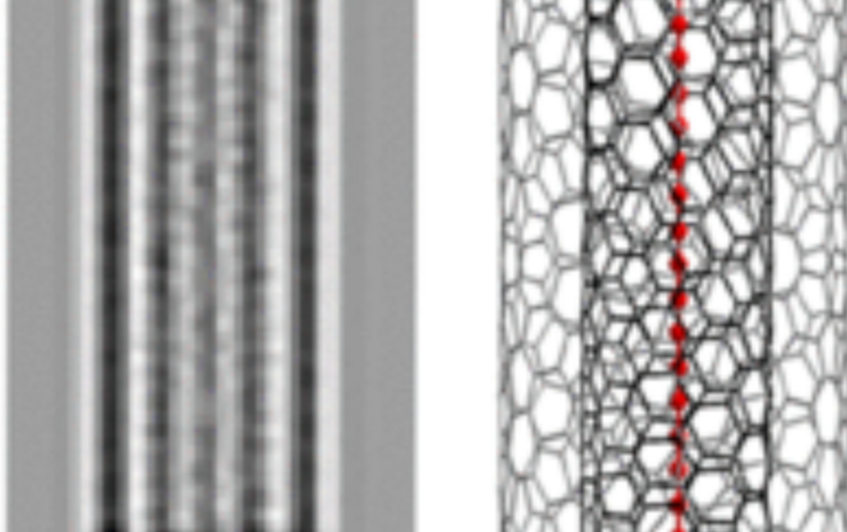Carbon nanomaterials
Team members
- P. Ayala, G. Kresse, T. Pichler and DCAFM fellows.
Dissertation Projects

Carbon chain inside DWCNT (TEM image and molecular model) [1].
Research carried out in the three dissertation projects of this area will focus on the electronic and optical properties of carbon nanomaterials. In the project of P. Ayala, carbon nanotubes with tailored functionality will be created by heteroatom doping with controlled distribution [2, 3]. The effect of these functional centers on the optical response of the heteronanotubes will then be investigated with advanced spectroscopic methods. Using similar methods, T. Pichler and his group will study carbon chains inside double walled carbon nanotubes and other carbon nanotube structures [1, 4, 5, 6]. These new systems with tunable band gaps are promising candidates for future nanoelectronic and photonic devices. The two experimental projects of this research area will heavily rely on the support of the computational project of G. Kresse, who will develop new electronic structure methods based on the Bethe-Salpether equation [7]. This methodology will enable accurate calculations of excitonic effects that are crucial for the interpretation of spectroscopic data.
[1] Shi, L. et al., Confined linear carbon chains as a route to bulk carbyne. Nat. Mater. 15, 634–639
(2016). DOI: 10.1038/nmat4617.
[2] Ayala, P., Arenal, R., Loiseau, A., Rubio, A. & Pichler, T., The physical and chemical properties of
heteronanotubes. Rev. Mod. Phys. 82, 1843–1885 (2010). DOI: 10.1103/RevModPhys.82.1843.
[3] Susi, T. et al., Silicon–Carbon Bond Inversions Driven by 60-keV Electrons in Graphene. Phys. Rev.
Lett. 113, 115501 (2014). DOI: 10.1103/PhysRevLett.113.115501.
[4] Senga, R., Pichler, T. & Suenaga, K., Electron Spectroscopy of Single Quantum Objects To Directly
Correlate the Local Structure to Their Electronic Transport and Optical Properties. Nano Lett. 16,
3661–3667 (2016). DOI: 10.1021/acs.nanolett.6b00825.
[5] Vecera, P. et al., Precise determination of graphene functionalization by in situ Raman spectroscopy.
Nat. Commun. 8, 15192 (2017). DOI: 10.1038/ncomms15192.
[6] Shi, L. et al., Electronic band gaps of confined linear carbon chains ranging from polyyne to carbyne.
Phys. Rev. Materials 1, 075601 (2017). DOI: 10.1103/PhysRevMaterials.1.075601.
[7] Vinson, J., Rehr, J. J., Kas, J. J. & Shirley, E. L., Bethe-Salpeter equation calculations of core
excitation spectra. Physical Review B 83, 115106 (2011). DOI: 10.1103/PhysRevB.83.115106.
